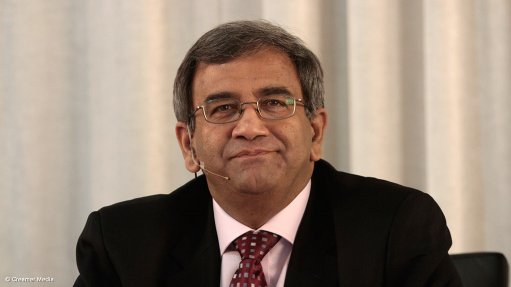
AngloGold Ashanti CEO Srinivasan Venkatakrishnan
Photo by: Duane Daws
CAPE TOWN (miningweekly.com) – Cost-disciplined gold major AngloGold Ashanti had entered into a sweet spot of strong leverage to the gold price, currencies and the low oil price, CEO Srinivasan Venkatakrishnan (Venkat) told the Mining Indaba on Tuesday.
“I’ve never felt more optimistic about our performance for the next two to three years. Our investment case is stronger than ever,” Venkat told the bustling conference, attended by 7 000 mining professionals.
While applying relentless two-year cost discipline across direct, indirect and capital expenditure (capex), the company simultaneously managed to grow production by 12% to 4.4-million ounces of gold a year, which was now providing exceptional leverage to the gold price.
In addition, it was leveraging off sub-dollar currencies in South Africa and across many of the countries in which it operated, including Argentina, Brazil and Ghana, and also enjoying the drop in the price of fuels because of its widespread use of diesel.
To adapt to the gold price falling 33% in two years, AngloGold succeeded in cutting $500-million out of its all-in sustaining cost base and came close to halving capex, eliminating the $1-billion cash burn of 2013 and becoming free cash flow positive.
Venkat said that none of the cost cutting had come at the expense of safety, with the company notching up a 67% reduction in fatal accidents in the same two-year period.
For the first time, AngloGold’s South African operations achieved one-million fatality-free shifts across all of the business units.
The $900-million a year sustaining capex still being invested is going into a new high-grade mill at Cripple Creek & Victor, the Below 120 Level project at the deep-level Mponeng mine in South Africa, where Phase 2 is beginning, and the redevelopment of stalled Obuasi mine in Ghana.
Corporate and exploration costs had fallen by 60%, with exploration expenditure being restricted to game-changing discoveries, notably in Colombia.
In South Africa, the new reef-boring technology was continuing to improve production and unlock areas too dangerous to mine.
Removing loss-makers was a continuing focus and a priority for 2015 was to get a robust feasibility study completed on Obuasi to enable it to restart as a modern, mechanised mine that offered a competitive return on investment.
The second priority area was to consolidate the South African operations to capture regional synergies and the third priority area was to enter into asset partnerships in Colombia, consider asset disposals and use free cash flow to cut debt levels.